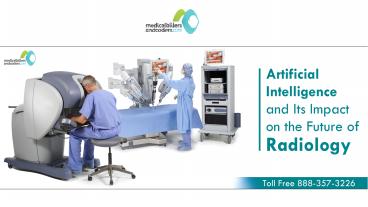Artificial Intelligence and Its Impact on the Future of Radiology - PowerPoint PPT Presentation
Title:
Artificial Intelligence and Its Impact on the Future of Radiology
Description:
Artificial intelligence which is the imitating human understanding by computers is now finally a reality in the medical field. Combining medical data with AI will change a lot of medical specialists like radiologists. – PowerPoint PPT presentation
Number of Views:449
Title: Artificial Intelligence and Its Impact on the Future of Radiology
1
(No Transcript)
2
Artificial Intelligence and Its Impact on the
Future of Radiology
Ever imagined a technology telling you that you
are diagnosed with cancer seeing your mammogram
report or CT scan? Radiologists are surely needed
to supervise diagnostic process but "Artificial
Intelligence" is creating its own space in the
medical field. It has definitely becoming an
integral part of daily routine in diagnosing
simpler cases. While automation enhances and
improves the role of information specialists,
there is still a need for the human
perspective. Artificial intelligence which is
the imitating human understanding by computers is
now finally a reality in the medical field.
Combining medical data with AI will change a lot
of medical specialists like radiologists.
Although there is worry of AI replacing such
specialists, in effect, AI is a decision support
technology to enhance radiologist ability to
diagnose correctly. The future of AI for
Radiology The ability to mine the endless
amounts of imaging data is driving AI innovation
forward in radiology however, as this disruptive
technology and its data applications begin to
find a more defined role, there are questions
around its impact on the future of the industry.
3
Artificial Intelligence and Its Impact on the
Future of Radiology
- AI and deep learning have a wide range of
applications and potential in radiology
spanning from improved diagnosis, enhanced
workflow and inevitably, a shift in the
radiologist's role. - AI in radiology, for example, is designed to help
tease out and prepare data for the radiologist,
but as it relates to evaluating scans and
diagnosis, the understanding of the interaction
between the imaging physics and the disease
biology is better done by the radiologist. - A merging of these two data-rich fields will
allow the information specialist to understand
the important data and manage the information in
the clinical framework of the patient to help
guide clinicians. It's a natural combination in
this perspective and there are three phenomena
happening now driving these compelling
integrations - Correlation and aggregation of data
- Emergence of computational framework
- The digitization of pathology
- Will Radiologists Be An Endangered Species?
- Will these "advancements" in AI force
radiologists to look for new lines of work? No,
it doesn't seem so. Artificial Intelligence still
has multiple hurdles to clear before it sends
human radiologists on their way.
4
Artificial Intelligence and Its Impact on the
Future of Radiology
As a first-of-its-kind application, as of now,
there is the approval process in place to
evaluate imaging AI products for compliance with
FDA 510 (safety regulations). Especially in the
case of radiology, the smart learning necessary
to get an AI application fine-tuned and fully
up-to-speed involves scanning and analyzing vast
multitudes of sample images. Even if AI
applications someday boast a 99 percent accuracy
rate, that one percent of misread automated
diagnoses may trigger a slew of potentially
landscape-altering lawsuits. Referring
physicians will likely be slow to adopt
computer-generated imaging diagnoses without the
human element from a seasoned radiologist
communication, image optimization, quality
assessment and more. Radiology in AI Doesn't
Fear the Future Over the foreseeable years, AI
and human radiologists won't become an either-or
proposition. AI applications will continue to
become a primary tool of computer-aided
detection, a symbiosis where AI automation
empowers radiologists to focus on tasks which
require the human-centric intelligence computers
still won't deliver a relationship greater than
the sum of its parts.































